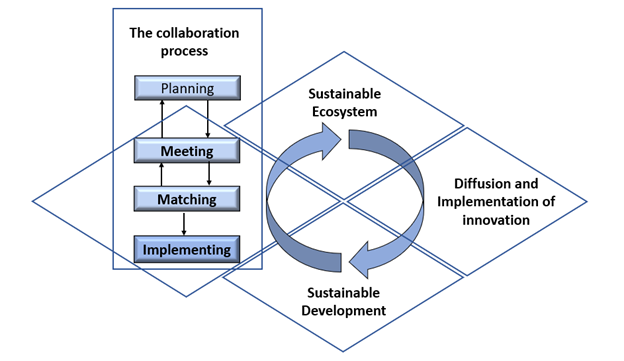From Innovation to Sustainability: Through Collaboration
Disclaimer: The French version of this editorial has been auto-translated and has not been approved by the author.

Nasrin Sultana
Postdoctoral Fellow
McGill University
There is a lot of talk these days about innovation and innovation ecosystems, linking sustainability and sustainable development. But how can innovation lead to sustainability or the achievement of the Sustainable Development Goals (SDGs)? Before answering this question, we need to have a clear understanding of what is meant by innovation or the innovation ecosystem.
Innovation is usually seen as the introduction of new products and services, new processes in production or delivery methods, or new ways of organizing and managing work. One might ask how these introductions of new products, processes, methods, or practices, in other words, innovation, happen. Well, innovation does not happen in silos; multiple actors must work together for an innovation to be successful. Collaboration is essential to reach the necessary scale of research efforts, production, and distribution of digital technologies and innovations. The question now is how these multiple actors come together to achieve their common goal. The answer lies in the idea of the innovation ecosystem. In an innovation ecosystem, the focus is usually on the introduction of a new product or service or a new way to create value for customers by introducing a new or changing an existing business model. An innovation ecosystem provides an environment for actors with a wealth of technical expertise, business experience, and access to capital that supports innovation. Actors in an innovation ecosystem interact and collaborate toward a common goal of the entire innovation ecosystem. Although innovation ecosystems can be virtual due to digitization and globalization, they need a grounded hub because members need to meet physically to interact and co-create new ideas that benefit from their multidisciplinary skills and competencies.
Innovation is widely recognized as a key mechanism for addressing sustainable development concerns. Actors from different sectors often work together to develop a business model around emerging sustainability-oriented innovations or to solve major societal problems. Therefore, collaboration between different actors seems to be very important for both innovation and sustainability. Again, how does collaboration between actors in innovation ecosystems come about? From the idea of the innovation ecosystem, we know that there are some highly connected actors who build bridges between different actors. Such actors are called intermediaries. They play an important role by facilitating the process of collaboration for innovation leading to sustainability in the ecosystem and by supporting the diffusion and implementation of innovations leading to sustainable development. In other words, intermediaries provide the necessary links between actors and create opportunities for the development of relationships and cooperation between different actors in an ecosystem.
The sustainability of innovation ecosystems depends on cooperation between actors in an open environment. However, we need to keep in mind that sustainability is not an automatic outcome of innovation activities. Achieving sustainability requires not only resources and the ability to manage those resources but also the ability to manage relationships and develop partnerships. So how do intermediaries facilitate collaboration in innovation ecosystems and potentially help ensure sustainability?
Actors need to collaborate and select collaborative partners in desired locations to ensure the diffusion and adoption of their innovations. The process of collaboration between actors in innovation ecosystems is iterative, involving different steps such as planning, meeting, matching, and implementation, and intermediaries connected to different actors facilitate the process (Figure 1). Intermediaries help organizations identify appropriate collaborators, support the process of collaboration, and manage the network of collaborators. For example, innovation intermediaries are public or private organizations that support firm- and system-level innovation in a variety of ways, such as creating knowledge links between organizations, sharing knowledge about specific technologies, providing knowledge-intensive services, and advising policymakers. By building cross-ecosystem linkages, innovation intermediaries can support the diffusion and adoption of digital technologies and innovations to bridge the gap between actors in different ecosystems, improve their innovation performance, and drive growth in target sectors.

Figure 1: Sustainable innovation ecosystems and the role of intermediaries
In particular, we need to understand the dynamics and mechanisms that contribute to the emergence of innovation ecosystems in a region in order to facilitate the creation of a successful innovation ecosystem and formulate favorable innovation policies. It is also important to understand the links between actors in innovation ecosystems in order to facilitate innovation, create shared knowledge, and achieve sustainability. Intermediaries increase the relational proximity between actors in different ecosystems, enabling them to pursue opportunities in distant locations in an efficient and agile manner. A globally integrated ecosystem expands the scope and opportunities for all actors to diffuse and adopt innovations. In addition, these understandings have broader implications for achieving sustainable innovation ecosystems and the Sustainable Development Goals (SDGs). For example, a nuanced understanding of the process of collaboration in the context of the innovation ecosystem will help us achieve SDG 9 – “build resilient infrastructure, promote inclusive and sustainable industrialization, and foster innovation.” By facilitating collaboration between actors within and across ecosystems, intermediaries support the diffusion of innovation. This understanding has important implications for building sustainable innovation ecosystems and achieving sustainable development goals.
To sum up, there are different types of innovation and different types of collaborators, and there is evidence that the extent to which actors collaborate and the types of actors with whom they collaborate affect the actors’ innovations. However, collaboration does not necessarily affect all types of innovation in the same way, nor do all types of collaboration affect innovation in the same way. Therefore, policymakers need to take initiatives based on the specific circumstances of different actors in order to foster innovation in the ecosystem. Regulations and policies should be adapted to the transitions and transformations taking place in the environment to strengthen collaboration between actors, better manage innovation ecosystems, and remain sustainable. By understanding the role of innovation intermediaries, actors can make efficient use of their resources and policymakers can allocate resources to build and sustain ecosystems and target sectors to foster innovation.
References
1. Sultana, N., & Turkina, E. (2023). Collaboration for sustainable innovation ecosystem: the role of intermediaries. Sustainability, 15(10), 7754.
2. Goal 9 | Department of Economic and Social Affairs (un.org)

